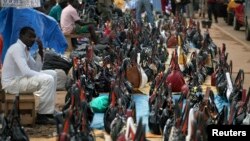The six nations that make up the Central African Economic and Monetary Community wrapped up their eighth annual “CEMAC Days” event with a dismal assessment: Central Africa is failing its efforts to achieve regional integration.
CEMAC consists of Cameroon, Chad, Equatorial Guinea, Republic of Congo, Gabon and the Central African Republic.The regional bloc was formed in 1994. Since then, CEMAC President Pierre Moussa said, little has been achieved to improve daily lives in the region.
He said central African states have been working at regional integration since they gained independence in the 1960s but are still not able to ensure the free movement of people and goods. This has kept the countries among the least developed in Africa. He said member nations are preoccupied by self-interest and a belief that each state can develop on its own. He thinks that is the major obstacle to integration. He also cited security issues as keeping the region from concentrating on economic development.
The CEMAC chief offered a dismal report card: 30 percent of people in the region go hungry, he said, while 70 percent live on less than $1 a day.
Experts say the conflict in the Central African Republic and the regional spillover of the Boko Haram insurgency have diverted attention from development.
Ambitious plans to create a regional airline, to build roads linking regional capitals and to create a regional stock exchange have remained just that: plans and aspirations.
Only Cameroon and Gabon have started issuing biometric passports, despite a January 2014 deadline.
The region is not yet a visa-free zone. So far only Cameroon and Chad allow their citizens to travel between the two countries without visas, following a bilateral agreement.
Member states have however reached agreements on reduction of customs duties of up to 70 percent for some basic goods like sugar and farm produce.
Besides CEMAC, the region is also part of a larger economic bloc, the Economic Community of Central African States (ECCAS). ECCAS shares many of the same objectives as CEMAC and also includes Angola, Burundi and Sao Tome and Principe.
Gabonese analyst and integration expert Emmanuel Bimbo said there has been a misallocation and duplication of resources.
"The impact of this overlapping scheme is negative because since they are working on the same program, it means that they are wasting resources and time. The region is not advancing too well as the other sub regions of the continent. They have to put in practice what the heads of state have decided. The objective of the African Union is to move to one economic community for the continent around 2028,” said Bimbo.
Economic growth last year for the six CEMAC member states did not top three percent, a disappointment compared to the six percent growth that was forecast.







